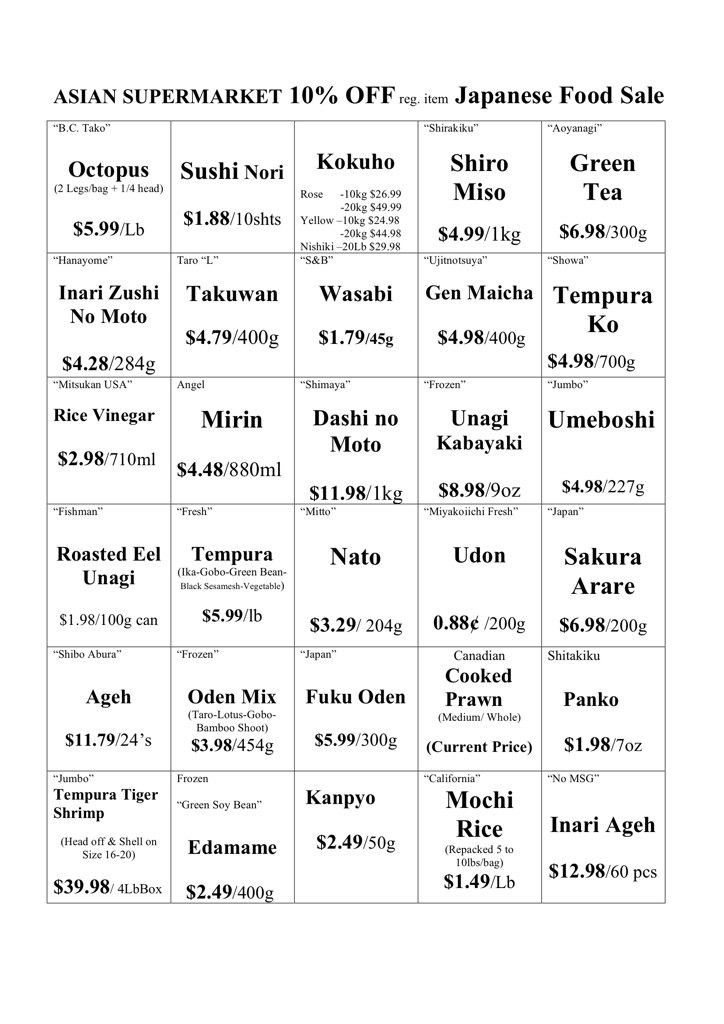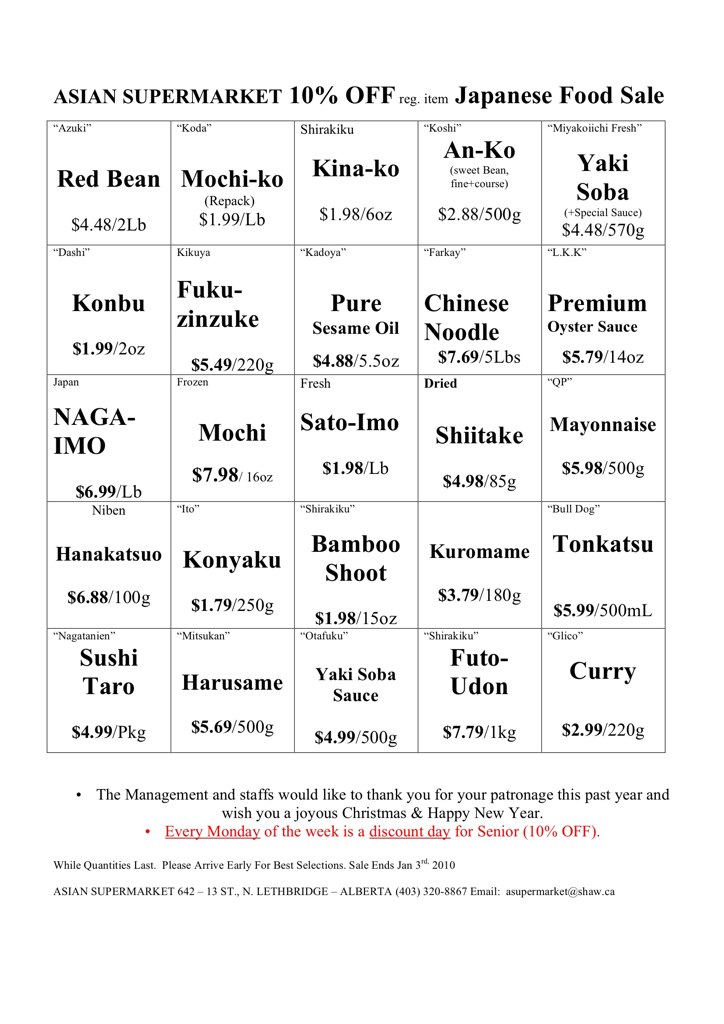We are a World Food Supermarket. This blog is to share with you our thoughts, recipes, and what is going on in the ethnic community. We also feature new products here and our residential foodie blogger, Brian Ly from Toronto! Sign up for our Food Story Action!
Saturday, December 26, 2009
Daikon Salad with Umeboshi dressing (via fork.ca)
Enjoy the recipe and as usual, all ingredients can be found at your local Asian Supermarket.
Happy Holidays and All the best!
DAIKON SALAD WITH UME DRESSING
Ingredients
For the Dressing:
2 tablespoons sesame oil
2 tablespoons soy sauce
2 tablespoons sugar
2 tablespoons rice vinegar
2 teaspoons ground black pepper
1 tablespoon black sesame seeds
1 tablespoon mayonaise
1 teaspoon lemon juice
For the Salad:
1/4 cup grated daikon
1 teaspoons minced umeboshi
1 cup shaved daikon
1/4 cup pea shoots
4 cups mixed greens
2 cups coined carrots
Garnish:
1/4 cup shredded seaweed
Bonito flakes
Directions
1. MAKE THE DRESSING:Mix all of dressing ingredients and add to the shaved daikon and ume boshi. Mix and chill.
2. COMPOSING THE SALAD:Put mixed greens in individual bowls. Add shaved daikon and carrots. Place pea shoots, bonito flakes and seaweed on top. Spoon over dressing mixture and sprinkle with additional sesame seeds. Serve immediately.
Cheers
Friday, December 18, 2009
Christmas Specials
• Every Monday of the week is a discount day for Senior (10% OFF)
Tuesday, October 6, 2009
Rice Water for Healthy Skin
I never knew all these years washing my rice that the water could be so beneficial to my skincare. Here her tutorial:
Rice Water for Healthy Skin
Enjoy and have a wonderful day!
Tuesday, July 21, 2009
Tuesday, July 7, 2009
Chicken Coconut Jalfrezi
Preparation: 10 mins Cooking: 15 mins
Here is what you need:
- 1 tbsp desiccated coconut
- 1 tbsp vegetable oil
- 400g chicken breast cubed
- 2 tbsp Patak's Jalfrezi Paste
- 1/2 large red chilli, deseeded and thinly sliced
- 2 spring onions, sliced diagonally
- 1 red pepper, sliced
- 1 tomato, chopped
- 1 tbsp fresh cilantro, chopped
- sugar, to taste
- salt, to taste
- Place the coconut in a large frying pan over a medium heat, cook for 1 - 2 minutes, shaking the pan to keep the coconut moving until it turns a light toasted brown. Tip into a bowl and set aside.
- Add the oil to the pan, and add the spring onions. Cook for 2 minutes.
- Add the Patak's Jalfrezi Paste. Sprinkle in a little water if the paste begins to stick.
- After 2 minutes add the tomatoes and peppers and a few tablespoons of water. Allow the tomatoes to break down.
- Add the chicken. Allow to cook for 5 minutes and check the chicken is cooked through. Check the seasoning and adjust the salt and sugar if required.
- Garnish with the red chilli and toasted coconut and sprinkle with the coriander.
- Serve with plain basmati rice.
Wednesday, June 24, 2009
German Kaffee Time
Sunday, June 21, 2009
A great start off to summer!

Print and present to the cashier. Have a wonderful start to the summer!
Cheers,
Asian Supermarket
New Products
POLISH
PAOLA FRUIT SYRUPS ... BLACK CURRANT, SOUR CHERRY, RASPBERRY SYRUPS, MATJAS HERRING, MASLO, FLAKI, BORSCH SOUP, SOS, HORSRADISH, BE
 ETS, JAMS, VEGETA SEASONING, GINGER BREAD, DELIJIC, CRACKERS, CANDIES ... MORE
ETS, JAMS, VEGETA SEASONING, GINGER BREAD, DELIJIC, CRACKERS, CANDIES ... MOREHUNGARIAN
SPIRAL -THIN -SQUARE NOODLES, PAPRIKA, HOT PEPPERS , GOULASH, MUSTARDS ... MORE
GREEK
WINE LEAVES, DOLMADAKIA STUFFED WINE LEAVES, KALAMATA OLIVE & OLIVE OIL, BACLAVA, OUZU & CINNAMON CANDIES ... MORE
ITALIAN
PASTA, TOMATOES, CANNED BEANS, ANCHOVIES, BACALAO, SAVOIARDI, DELICIOUS BISCUITS... MORE
CROATIAN
AJVAR, PLUM BUTTER JAM, ROSEHIP JAM, PICKLE YELLOW & RED PEPPER , ROASRED RED PEPPER, DJUVEC, PEFFERONI HOT PEPPER, GOULASH, SUDZUK, ARGETA, CHICKEN LIVER SPREAD, VEGETA ...

JAPANESE
RICE COOKERS, RAMEN, UDON, SOMEN, MOCHI, MISO, MACHA POWDER, GREEN TEA, GENMAI CHA, SUSHI RICE & SUSHI INGREDIENTS, SASHIMI TUNA, SALMON, FISH CAKE, TEMPURA, RICE BAG, TAKUWAN, MISO, CURRY, TAMARI SOYA SAUCE, LOW SODIUM , WHEAT FREE SOYSAUCE

THAI
JASMINE RICE $15.98 / 17.6 lbs(8kg), BROWN JASMINE RICE, RED RICE, BLACK GLUTINOUS RICE, TOM YUM,PAD THAI, FISH SAUCE, SWEET CHILI SAUCE ...
FILIPINOS
MILAGROSA RICE, LONGANISA, TOCINO, TINAPA, TUYU, SARDINE, CENTURY TUNA, TALAPIA, MILK FISH, GALUNGUN, ALAMANG, BAGAOONG, PATIS, SOY SAUCE, BANANA SAUCE, LECHEON SAUCE, COCONUT VINEGAR, SUGARCANE VINEGAR, PALM VINEGAR, CANTON, BIHON, PALABOK, SKYFLAKE BISCUITS, GROWER PEANUT, HOPIA, BALUT, PANDASAL ... MORE
VIETNAMESE
SPRING ROLL, SPRING ROLL DIPPING SAUCE & PEANUT SPRING ROLL DIPPING SAUCE, SAIGON STYLE STY-FRY & MARINADE SAUCE, CHAR-BROIL LEMONG
 RASS MARINADED MEAT, BEEF BALL, LEMONGRASS PORK BALL, RICE VERMICELLI, RICE PAPER, SEASONING FOR PHO - BEEF NOODLE SOUP recipe, BEEF STEW, HUE SPICY BEEF NOODLE, HOT & SOUR SOUP ...
RASS MARINADED MEAT, BEEF BALL, LEMONGRASS PORK BALL, RICE VERMICELLI, RICE PAPER, SEASONING FOR PHO - BEEF NOODLE SOUP recipe, BEEF STEW, HUE SPICY BEEF NOODLE, HOT & SOUR SOUP ...KOREAN
HOT PEPEER PASTE, SWEET POTATO NOODLE, RICE CAKE, DUMPLINGS, SEAWEED, UDON, SOMEN
CHINESE
WHITE, RED, GREEN, OOLONG TEA, BODISLIM TEA, GINGER TEA, LUNG, KIDNEY, LIVER FLUSH TEA ...MORE
MEXICAN
CHORIZO, TORTILLAS, BEANS, SALSA , VALENTINA SAUCE, JABANERO SAUCE, JALAPENOS, SERRANO PEPPER, HARMONY, MOLE, TOSTADA
SALVADORIAN
MASECA CORN FLOUR, RICE FLOUR,TORTILLAS, TAMALES, PUPUSAS, FRIJOLES FRITO, QUESO, MANTAQUILLA, PAN DULCE, SEMITAS
COSTA RICAN
LIZANO SALSA SAUCE,
PARAGUAY & ARGENTINA
YERBA MATE TEA
USA
RICE FLOUR, BROWN RICE FLOUR, SOYA FLOUR, POTATO FLAKE
Monday, April 27, 2009
Macrobiotic Diet - Dulse Condiment

Wednesday, April 8, 2009
Wednesday, March 11, 2009
Chinese Dumpling Recipe

As seen on our tv commerical we are happy to provide you our simple and easy Dumpling recipe:
What do you need?
1.1lbs ground pork
1/2 cup chopped green onions
1 cup chopped chinese cabbage (Siu Choy) (blanched)
1/2 cup carrots finely minced or grated
1 tbsp minced garlic
1 tsp minced ginger
1 tbsp soy sauce 1 tbsp sesame oil
1 egg
salt and pepper to taste
in-store dumpling wrappers (thaw 2hrs before combining ingredients)
Now what to do?
1. Combine all ingredients and mix altogether. Let sit for about 20 minutes so that the meat gets the full flavour.
2. Now take a mini-spoon full of meat and place in the middle of the wrapper.
3. Either damp the wrapper's edges with water or egg white.
4. Fold and press together. Either crimp the edges together or use a fork and pinch.
How to cook them?
1. Heat wok or pan and add 2tsp oil.
2. Fry the dumplings until golden brown on bottom (and sides if you wish).
3. Then add 1/2 cup water and cover and let steam. Turn heat down to medium. Add more water if wok dries out.
How to enjoy them?
Enjoy your
 self-made dumplings with Dumpling sauce or make your own!
self-made dumplings with Dumpling sauce or make your own!What you will need:
1/2 cup soy sauce
1/4 cup vinegar
2 tbsp mirin
1 tbsp sesame oil
1 tsp sugar
1 tbsp minced onion
1 tsp minced ginger 1 tsp minced garlic
1 tsp minced green pepper (add dried or fresh chilli if you want it spicy!)
1. Combine all sauce ingredients
----------------------------------------------------------------------------------
Now enjoy your self made dumplings with self-made sauce!
Please share with us your experience and pictures!
Cheers,
Asian Supermarket
Sunday, March 8, 2009
Early Spring Saving! March Coupon
We also carry a large selection of European Chocolate -- dark to yoghurt with chilli or just plain milk or nougat.
Come to your One Stop Shop!
Tuesday, February 3, 2009
Asian Tea
Oolong
1. Tie Kuan Yin
2. Taiwan Oolong
3. Oolong with orange pekoe
4. Anxi Oolong
5. Japanese processed Oolong
6. Teochew Oolong
7. Yunnan Oolong
8. Sweetened processed oolong tea only availabe in Singapore and Malaysia
9. Infused Fragrant Oolong tea
10. Kinmen or Jin Men Oolong
11. Virgin Fujian Oolong tea leaves
Japanese too lov
Black tea is fermented and there are about twenty main types of black tea in China.
 Basically the formula is x tea + y flowers = yx tea.
Basically the formula is x tea + y flowers = yx tea.
Thus in Chinese language terminology:
Oolong tea + Jasmine flower= Jasmine Oolong tea
 It is made by high pressure compression into shapes resembling bricks. Thus, they can also be known as brick tea. In fact, this is the direct translation of its original Chinese terminology.
It is made by high pressure compression into shapes resembling bricks. Thus, they can also be known as brick tea. In fact, this is the direct translation of its original Chinese terminology.
Some classifiy tea leaves according to the nature of compression.
 Ginseng has multiple benefits according to Chinese medicine. It could bring heatiness down for example. Heatiness is caused by hot weather, stress or spicy food. Its symptons could be sore throat, rashes etc. There are many other purposes of drinking ginseng tea.
Ginseng has multiple benefits according to Chinese medicine. It could bring heatiness down for example. Heatiness is caused by hot weather, stress or spicy food. Its symptons could be sore throat, rashes etc. There are many other purposes of drinking ginseng tea.
Green tea in Asia is almost as popular as coffee is in the West. Japanese, Chinese and Taiwanese green teas are filled with polyphenols which phytochemicals that are almost as 100 times as powerful as the antioxidant found in Vitamin C. Tea's polyphenols is primarily known as catechins that prevents the uncontrollable growth of new blood vessels. This, many believe,help to stop cancer by preventing newly-emerging tumors from growing by robbing them of their sustenance for growth. Catechins can also stop DNA deformations caused by carcinogens or cancer-causing substance from coming up in the first place. 
Thursday, January 29, 2009
Wednesday, January 28, 2009
Ying Yang Rice

Ying Yang Rice (serves 4)
Ingredients:
* 1 1/2 cup cooked white rice (heat in microwave)
* 2 eggs
* 10 jumbo shrimp, peeled and de-veined
* 2 chicken breast, cut into bite-size pieces ( I like it in strips)
* 1/3 cup green peas
* 1 medium tomato, sliced
* 1 small onion, sliced
* 1 1/2 teaspoon sugar
* 1 1/2 teaspoon salt
* 1 1/2 teaspoon cornstarch
* 1 tablespoon vegetable oil
* 1/3 cup ketchup
* vegetable oil, for stir frying
* salt
* sugar, to taste
Cooking:
- Separate egg yolks and egg whites.
- Combine chicken with sugar, salt, corn starch, and vegetable oil. Set aside.
- Heat wok with 1 tablespoon oil and a sprinkle of salt.
- Add rice and break it apart with spatula after heated in the microwave.
- When it has heated through, add the egg yolk and mix in well until egg is cooked.
- Place rice on serving deep-dish (platter), preferably one with high sides to contain the rice and toppings when done.
- Heat 1/2 teaspoon of oil in wok. Stir fry peas for about 30 seconds, remove and set aside.
- Heat 1 teaspoon of oil in wok. Add shrimp and stir fry about 5 minutes, stirring constantly so the shrimp does not shrivel up.
- Pour in egg whites and sauce solution of water and corn starch, mix well.
- When it is cooked through, adjust taste with salt, then spoon over one side of the rice to create a Yin Yang symbol with a slight curve in the center of the rice. Rinse out wok and return to heat with 1 teaspoon oil sprinkled with a little salt.
- Add onions and cook for about 1 minute, add sliced chicken and stir well.
- When the chicken is about half cooked, add sliced tomatoes and continue stirring until chicken is done.
- Add ketchup and mix thoroughly. Adjust flavor with a little sugar as desired to balance out the tartness of the tomatoes.
- When done, spoon over the other half of the rice, filling in the curve of the other half.
And yes we carry all items in stock!
642- 13th Street North
Lethbridge, Alberta
403-320-8867
Come in and find out!
Saturday, January 24, 2009
8 Chinese New Year Food Symbols for Happiness, Prosperity and Health

phillyBurbs.com
Lucky Chinese New Year symbols are an important part of celebrating the Spring Festival. For it marks the start of spring and a perfect time to have your New Year wishes come true.
And what better way to usher in happiness, prosperity and health than to enjoy "auspicious food" with family and friends?
Here are the Top 8 auspicious food symbols for Chinese New Year.
These delicious dishes are served during the reunion dinner on Chinese New Year's eve with family members.
Top 8 Auspicious Food Symbols for Chinese New Year
1. Hot Pot
A steaming hot pot (or Chinese fondue) with meat, seafood and vegetables is a must. The Chinese word as for Hot Pot means “prosperous and booming.”
2. Fish
Another must-have dish if you want to experience abundance in the New Year.
Fish is the most popular dish served during Chinese New Year. In Chinese the word for fish has the same sound as “surplus” and “abund
 ance.” Typically, a whole fish is served on Chinese New Year’s Eve for the reunion dinner. Usually the fish is steamed. It is a good omen to leave the bones and head and tail intact. It symbolizes surplus, abundance and a good beginning and end in the new year. Fish is best served whole.
ance.” Typically, a whole fish is served on Chinese New Year’s Eve for the reunion dinner. Usually the fish is steamed. It is a good omen to leave the bones and head and tail intact. It symbolizes surplus, abundance and a good beginning and end in the new year. Fish is best served whole.
3. Shrimp
Eat shrimp for overall happiness and well-being.
4. Boiled Dumplings
A Chinese New Year tradition is eating boiled dumplings. They are shaped like gold ingots.

The Chinese word for dumplings means the hour of transition into the New Year. In northern China, dumplings filled with meat are eaten on Chinese New Year’s eve to usher in good luck and wealth in the New Year. Sometimes a coin is placed in one of the dumplings. Whoever bites on it will have plenty of wealth in the new year.
When dumplings and yellow noodles are cooked together they mean “golden threads through gold ingots.” In the eastern cities of China, like Shanghai, Hangzhou and Suzhou, egg dumplings are eaten as they look like gold ingots.
5. Oysters
The word for oyster is similar to the word which means “good things.” In southern China, oysters are served with thin rice noodles.

6. Green vegetables
Typical New Year’s menus include plenty of green vegetables. They are believed to be good for close family ties.
7. Sticky Rice Cake
Eating these steamed cakes made of rice flour and topped with red dates has the meaning of attaining greater prosperity and rank in the new year.
8. Noodles

Often referred to as "longevity noodles,” they offer a wish for good fortune, good luck, prosperity, longevity, happiness and abundance, which are central to the Chinese way of life. Even more so during Chinese New Year!
And yes we do carry all of these items! So print the 12% off voucher and redeem while all quantities last!
Cheers,
Happy Chinese New Years!
Chuc Mung Nam Moi -- Happy New Years -- Gong Hey Fat Choi ---







